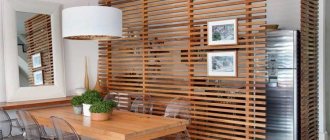Podium
This design will help out if there is no space in the apartment to erect extra partitions. An amazing property of the podium is its ability to zone the living room without losing useful space: you can store things inside it or even hide a bed. At the same time, the space will not look overloaded.
The sleeping place can be located either on the podium or inside it: in the second case, a sofa is placed at the top. Often, an office is set up on a raised platform, the zoning of which is complemented by curtains.
Partitions as a zoning option
Glass partitions serve as space delimiters not only in the office, but also at home. In height they can be either 90 cm or right up to the ceiling. Glass for partitions is not only transparent or frosted, but also colored, tinted and with stained glass patterns.
- Partitions do not have to be stationary and voluminous. Sliding or hinged doors help divide any room into parts. Doors can be with inserts made of transparent or frosted glass, or opaque.
- Doors help completely block off a room from one wall to the opposite. Or only the necessary part of the room, even diagonally, if necessary.
- Often, partitions become racks using decorative plants, photographs, panels with figured carvings or forging. Such racks can be wooden, metal, plastic.
A special place is occupied by panels and walls where aquariums with fish or a working fireplace are mounted. This is both an art object and creates a cozy homely atmosphere.
Ceiling structures
The opposite option to the podium is to delimit the room using the ceiling. This solution allows you to visually divide the living room and lay additional communications inside. You can use both tension fabrics and suspended plasterboard structures.
If you provide multi-level ceilings with thoughtful lighting and decoration that differs from the main background, zoning will be implemented as functionally as possible. You can also divide the living room with beams, which will divide the space into several sections.
Changing floor and ceiling levels
Zoning of the living room 20 sq. m. can be achieved by raising part of the floor under an important functional area. If we are talking about the sleeping area, then this technique will also allow you to store bedding at the base of the podium. The boundaries of functional zones can be distinguished using differences in ceiling levels. When the ceiling height above the zones changes, a distinct feeling of transition from room to room is created. In this case, it would be appropriate to highlight private areas with a low ceiling, and the reception area with the highest.
Rack or cabinet
To delimit a room using a light shelving unit is a typical method in domestic interiors. Products made of metal, wood, chipboard and MDF are used. The shelving not only provides zoning for the living room, but also acts as a place to store books, photographs, flower vases and decor. A popular option is shelves decorated with house plants in pots.
Using cabinets and shelving, you can create niches and highlight the necessary areas - work, children's, reading or sleeping. This is the easiest and most inexpensive way to transform your interior and make it more comfortable.
For zoning small rooms, a through rack is more suitable, and for spacious ones - with a blank back wall.
Tips and tricks
Zoning requires precise calculations and complex organization, because in order to accommodate everything you need, you should clearly think through the entire strategy at the planning stage. We suggest that you do not ignore the following tips:
- Be sure to study the photos of living room zoning available in catalogs or on the Internet, select several suitable options;
- Consult a specialist; it’s better to overpay than to be left with nothing;
- Think through the layout as much as possible;
- Give preference to ordered furniture.
By dividing the living room into zones, you can catch up with all the “hares” at once: functionality, comfort, space saving, visual expansion of the area and placement of everything you need.
The main thing is to correctly calculate and make the most of all available square meters, since remodeling such rooms is difficult and expensive.
Curtains
To avoid overloading the room with furniture, use fabric. Curtains are a budget and practical option: they are installed by installing curtain rods, are easy to change and are easy to care for. Curtains can separate the sleeping area, creating an atmosphere of privacy with one movement of the hand.
An easier way to make a makeshift bedroom feel secluded is to hang a canopy made of thick fabric over the bed.
Curtains are a convenient solution for those who work at home in the evenings. An office can be arranged in the living room, creating a border between the sofa and the desk. This is a great idea for zoning a living room for those who seek privacy but are indifferent to extraneous noise.
Devices and items for dividing a room
The simplest devices in the form of a screen, curtains, curtains separate one zone from another in the living room. This design is easy to build yourself, choosing the material and size of the product at your discretion.
Thus, if you want to change the decor in the living room, move the resting place or combine all the zones into one, you just need to fold and move the screen or remove the curtain.
Sofa and other furniture
Zoning the living room can be done using a regular sofa: this is especially true for small rooms where it is not possible to erect a partition. A sofa, placed with its back to another functional area, copes both with dividing the space and with its main task.
If you need to differentiate between a kitchen and a place to relax, a sofa is often complemented by a dining table or a bar counter. In the lower photo, the room is divided into two zones by furniture - sofas, a console and a wardrobe, as well as multi-level ceilings and different finishes on the floor.
How to choose the right living room
Before you start purchasing the contents of the room (furniture), it is important to carefully plan the entire interior in the smallest detail. This process takes a lot of time and effort, especially for non-professionals, so to get rid of the hassle, it is better to contact a design company.
The first stage of planning will be to determine the functionality of the room. To do this, you need to draw on paper a detailed plan of the room, taking into account all window and door openings, niches, bay windows and similar elements. Then determine the purpose of the living room: will it be just a relaxation area, a study or a room for holding parties.
The filling of the room directly depends on this point, for example, for an office you will need a computer desk or a multifunctional bureau, a comfortable chair and several shelves for books and documents. Zoning of space is also quite popular in the design of the living room.
Read: How to choose good cement?
Most often, this technique is carried out by contrasting painting the walls in colors that are radically different from each other, or by light separation. It is worth noting that this technique is often used in the design of small spaces.
Visual zoning with color
Another way not to overload the living room is to implement zoning using decoration. To differentiate, use contrasting paint or wallpaper, creating a noticeable accent. You can also use different textures on the walls - decorative brick, wood, laminate.
In the photo below, the bedroom and living room are divided using dark blue wallpaper and a low shelving unit:
If the zones are made in different shades, then it is necessary to include accessories of the same tone that support the color scheme.
In this example, the bed is in a small niche, highlighted by dark trim and a low ceiling:
If the kitchen and living room are located in the same room, you can draw a boundary between the areas using different floor coverings: it would be more appropriate to lay ceramic tiles in the cooking area, and parquet, laminate or linoleum in the living area.
Zoning a square room into a bedroom and living room
In such a room, designers recommend abandoning the double bed - it is better to purchase a transforming sofa. If you can’t do without a bed, then:
- It is better to place the sleeping area in the corner of the room.
- It is advisable that part of the window remains open and there is natural light in the living room area.
- The zone can be separated not only in the form of a rectangle, but also a semicircle, by making a radius partition or hanging curtains on rounded guides.
Lighting
Thanks to the variety of lamps, as well as the ability to place them at different levels of the room, the living room can be zoned with light. It is recommended to place a floor lamp next to the sofa or reading chair. In the “bedroom”, wall sconces or lamps with dim light are appropriate; in the kitchen, lighting for the countertop and dining area is appropriate.
To achieve the best result, it is worth adding a carpet to one of the zones. In combination with light, it will allow you to divide the room without much expense.
An effective technique is to illuminate a multi-level ceiling, as well as the floor: the LED strip easily emphasizes the border of two zones and looks modern.
You shouldn’t settle on just one method of zoning when arranging a living room: many techniques can be successfully combined with each other.
Style decision
This option requires design skills. The method is to create your own style in each part of the room. For example, in an office or work area, focus on classic interior elements, and in the bedroom, emphasize more modern accents, abandoning the classics.
The transition from one zone to another can be made smooth and combined with other types of zoning: complemented with a color scheme, accent or screen.
Fabrics
Although zoning the living room with curtains looks somewhat old-fashioned, this option is simply inevitable in some cases. In an apartment of modest size, there is no other way to hide a sleeping place or computer desk from prying eyes.
When an area of the room is fenced off with thick fabric, privacy is guaranteed. In addition, textiles provide good sound insulation.
Suitable Models
Island sofas in the interior: features, types, how to choose Read more >
Not all sofa options are suitable for central zoning. When selecting this piece of furniture in a store, you need to choose only the most acceptable options in terms of size and type of layout. Standard books take up too much space; it is better to replace them with models with a roll-out mechanism, which are great for comfortable sleep at night and relaxation during the day.
A comfortable sofa unfolds as simply as possible; to do this, you need to pull out its lower part and place a soft seat on top. This model is well suited for small living rooms where you need to save additional free space. For those who are not embarrassed by the lack of linen drawers inside the sofas, the so-called “dolphins” are perfect. They are divided into two parts, one of which is pulled forward using a loop.
American and French folding beds also do not cause problems and are compact in size. These guest models are equipped with metal frames and take up little space when folded. When choosing the right models, people usually pay attention to their style and design, upholstery color and folding mechanism. The right furniture of this type should fit harmoniously into the interior and be combined with other items. If all zoning rules are observed, any model can be correctly placed in the center of the room.
Advantages of high ceilings
Rooms with high ceilings (more than 5 m) are perfectly divided into two vertical rooms with a staircase. The second floor comfortably accommodates a sleeping area, a dressing room, and a creative workshop.
Such zoning is expensive, but in return you get two full rooms. Wooden beams, floor panels, and metal structures on supports are used as partitions.
Wardrobe as a delimiter: pros and cons
Using a closet as a space divider is an old trick that has been used for many years. It allows you not only to reliably cover the bed, but also to solve the problem of storage space.
Wardrobe in living room and bedroom zoning
For additional convenience, you can mount the TV on a rotating mechanism at the border of the zones. By turning the TV, you can watch TV shows either while lying on the bed or sitting on the sofa in the living room.
The shelving between the zones also serves to divide the space. A model with a back wall and a light shelf are also suitable for this. The division, just like in the case of a closet, is functional.
Great solution for extra storage
A rack and cabinet add a feeling of bulkiness to the room, so this method of zoning is not suitable for small apartments.
What to consider when zoning space
If the zones allocated to the rooms are completely opposite in their purpose, then it is better to organize more than one central lighting, but in each zone to allocate its own, of different intensity. Various floor lamps and table lamps can be placed where they are most needed, and spot lighting will highlight exactly the area that needs to be better illuminated.
Attention! In a small living room, it is better to avoid large and bright accents, so as not to visually reduce the small area even further.
For the same purpose, it is better to use a uniform floor covering. Light wall decoration will visually enlarge the room, and multi-level ceilings and the installation of a podium will also be relevant.
You can expand your living space by adding an insulated balcony, where you can organize a work or dining area.
Having considered the methods and features of zoning a living room, everyone can imagine which option is most suitable for them and make the right choice. Now you can imagine the room of your dreams and take action.
Some useful tips
When choosing a sofa for zoning, you shouldn’t rush to the first option you come across. Having chosen the model you like, guess whether it can be successfully placed in any other point of the room. After all, one day the division into zones may get boring and the sofa will be out of place.
Pay no less attention to the appearance of the product. It must be presentable from all sides. Manufacturers often save on the backrest and make it from simpler upholstery material. You should not purchase such a model - if you want to turn the sofa towards the entrance, you will get an unflattering picture.
Remember the main thing: a correctly selected sofa will be able to successfully zone the space and will definitely complement its zone with the necessary functionality.
Saving space when zoning a room
When zoning the living room space, more furniture is installed than usual, so you need to try not to clutter up the already limited area too much. With the help of modern means, it is possible to save valuable space without compromising on comfort, and even gaining some advantages.
- Wall shelves will take up free space on the wall, adding usefulness to it, and they themselves can act as a valuable addition to furniture, serving as additional storage space for all sorts of necessities. In some cases, the shelves themselves can act as a means of zoning a room.
- A wall-mounted flat-screen TV will not require the purchase of a special table, which in turn will save about a square meter of space.
- Transformable furniture can be a real salvation for a small room. A place to sleep can be a storage area for bulky items during the day. Some ottomans can be transformed into coffee tables. Small tables are converted into large family or guest tables. You can even hide chairs in some designs, and, if necessary, remove several or all at once. Pull-out beds are a good option, especially for families with children, as they can be pulled out during the day and the free space can be used for play.
- Drawers in beds or podiums allow you to store a lot of things without using large closets.
- If there are high ceilings, a sleeping place can be arranged on the second tier, that is, you can organize a second floor for yourself. And under it, install additional shelves or a storage cabinet, or leave free space and use it according to circumstances.
- For a schoolchild, it is possible to allocate a separate “all in one” area - a table combined with a closet, and a loft bed on top.
- A workplace for an adult can be placed in a closet - a new and unusual move. When the doors are closed, it is completely hidden from prying eyes.
Transformable bed to save space
Methods for selecting zones
Ideas for zoning a living room and ways to highlight individual zones are very diverse - almost limitless. There are a large number of options with which even in the smallest room you can arrange, if not isolated, then clearly visible areas. For this purpose, partitions, various pieces of furniture, sliding doors, multi-level floors (podiums) and different color schemes are used.
Partitions
A partition for dividing a room can be made in partial or continuous form (with interior doors or an arched opening). The choice of design depends on the size of the area, the location of the window and other parameters of the room. The most commonly used partition is for zoning the kitchen and living room, since their functional purposes are very different.
There are different styles of such designs. Partitions made of glass, including frosted or mirrored ones, which visually expand the space, are especially well suited for dividing space.
Zoning the living room with plasterboard, fiberboard or chipboard plywood allows you to obtain partitions that imitate main walls. They are usually decorated to match the main finish or brick, complemented with glass or other decorative inserts. The advantages include strength, the ability to choose a shape and use various decorative elements. One of the disadvantages is the lack of mobility.
Furniture
Dividing one room into 2 or more using pieces of furniture is the most universal way of zoning. It is suitable for any size space, since it involves the use of both large cabinets that imitate a wall, and light racks or small shelves that do not clutter up the space even in the smallest rooms.
Installing a cabinet between zones requires practically no additional costs, since you only need to change its location in the apartment. Some expenses may be required if there is a desire to add height using mezzanines or make any other changes to make a completely blank partition. To complete the effect, this method is often combined with the installation of a door or curtain.
Zoning the living room with a shelving unit is the best choice for small areas or in cases where the window location does not allow the installation of solid structures. At the same time, the larger the sections, the lighter it will look and let in more light.
Sliding doors
Another great solution for dividing a room is a sliding door. The main advantage is that, if necessary, it can be closed, creating two, completely isolated spaces, and then opened so that the partition does not interfere and only takes up a small part of the area.
Such doors can have a compartment or accordion shape, be made of any materials, and decorated with glass or other decorative inserts. If there is only one window in the room, then you need to choose a material that allows light to pass through.
No repairs are required to install the structure. The main thing is that the chosen option fits harmoniously into the surrounding environment and is easy to open and close even for children.
Podium
Different floor levels allow you to visually divide the room without establishing any vertical boundaries. The podium is usually equipped with a seating area or a work/study area. This solution is most often implemented in a one-room or studio apartment.
The advantage of the podium is that it perfectly divides the space, without cluttering it or disturbing the integrity of the setting. To do this, it is important that the podium and the rest of the interior are designed in the same style.
Color Separation
The delimitation of space with the help of color involves the use of finishing materials and pieces of furniture of different colors. However, other zonal separators are usually not used. The exception is curtains, which do not affect the visual perception of the living room and can be pulled back at any time.
To separate one functional space from another, the following solutions are used:
- one wall or corner is painted in a color that differs from the general color palette, and it can either combine or contrast with it;
- floor coverings that are identical in texture and design, but different in color, are laid on the floor;
- two color options are combined, usually on the floor and ceiling, which are a mirror image of each other.
Even in the absence of physical separation (from partitions or furniture), different color zones are perceived as two separate spaces.
Features of space division
Zoning of any room is a way of dividing it into separate zones: a dining room, a study, a dining room, a place to relax, a corner for handicrafts.
The combined space has its positive aspects:
- Visual increase in the size of the room;
- There is no need to move from room to room if there are children in the house or guests come to you;
- Division into zones helps to highlight a personal corner even with a small area;
- Zoning increases the functionality of the room;
- The ability to create a unique, practical design.











